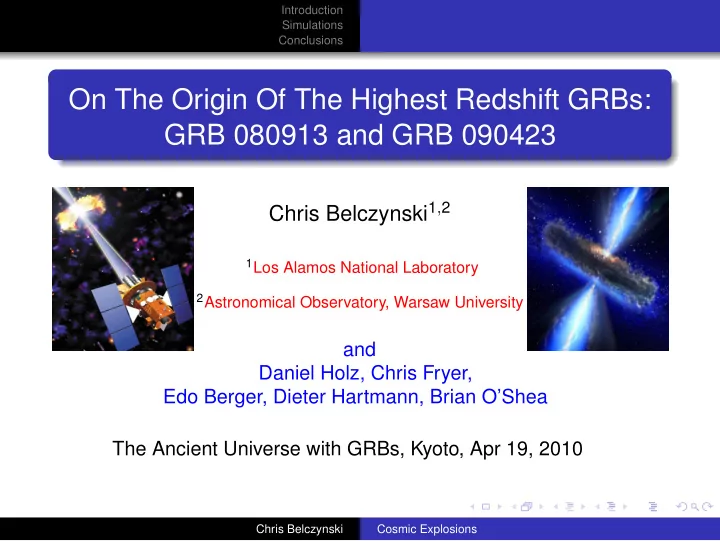

Introduction Simulations Conclusions On The Origin Of The Highest Redshift GRBs: GRB 080913 and GRB 090423 Chris Belczynski 1 , 2 1 Los Alamos National Laboratory 2 Astronomical Observatory, Warsaw University and Daniel Holz, Chris Fryer, Edo Berger, Dieter Hartmann, Brian O’Shea The Ancient Universe with GRBs, Kyoto, Apr 19, 2010 Chris Belczynski Cosmic Explosions
Introduction Simulations Observations & Questions Conclusions Introduction: Observations & Questions (1) GRB 080913: duration: 8 sec ( ∼ 1 sec in the restframe) redshift: z = 6 . 7 ( ∼ 800 Myr after Big Bang) (2) GRB 090423: duration: 9 sec ( ∼ 1 sec in the restframe) redshift: z = 8 . 1 ( ∼ 600 Myr after Big Bang) (3) Questions: Origin: Pop III or Pop II stars? Nature: long (collapsar) or short (merger) GRBs? (collapsar: single massive star; merger: NS-NS/BH-NS) Chris Belczynski Cosmic Explosions
Introduction Star Formation in Early Universe . Simulations Single and Binary Evolution Conclusions Collapsars & Mergers in Early Universe Simulations: Star Formation in Early Universe Star Formation History: Strolger et al. – fast rise: low z – maximum: z ∼ 1 − 2 – decline: high z (uncertain: extinction) Metallicity Evolution: – slow model: Pei et al. 1999 -5 -4 -3 -2 -1 0 (UV, optical and IR) – fast model: Young & Fryer 2007 (SDSS, Galex, Spitzer, Kamiokande) POP III – POP II transition: – our models: z ∼ 10 − 20 (slow-fast) – detailed calc: z ∼ 15 (Mackey et al.) Despite some recent claims: 0 5 10 15 20 25 GRB 080913 & 090423: Pop II stars Chris Belczynski Cosmic Explosions
. Introduction Star Formation in Early Universe Simulations Single and Binary Evolution Conclusions Collapsars & Mergers in Early Universe Simulations: Single and Binary Evolution Evolve Pop II Stars: pop. synthesis – long GRB: He/CO star + direct BH 1 − 10 % : high rotation required (Podsiadlowski et al.; Yoon et al.) – short GRB: NS-NS or BH-NS merger 1 − 40 % of BH-NS, 100 % of NS-NS and factor of ∼ 6 – pop. synthesis 2 4 6 8 10 12 Formation Efficiency: – collapsars: ∼ 2 − 20 per 6 × 10 8 M ⊙ ∼ 1 − 40 per 6 × 10 8 M ⊙ – mergers: Delay times: (SF -> GRB) – collapsars: ∼ 5 Myr – mergers: ∼ 100 Myr 0 2 4 6 8 10 12 14 Note (1) short delay times (2) similar formation efficiencies Chris Belczynski Cosmic Explosions
Introduction Star Formation in Early Universe . Simulations Single and Binary Evolution Conclusions Collapsars & Mergers in Early Universe Simulations: Collapsars & Mergers in Early Universe Calculate Intrinsic Rates: – standard cosmology: Ω m = 0 . 3 , Ω Λ = 0 . 7 POP II ONLY – cosmic SFR: Pop II stars only – propagate: collapsars and mergers Swift Detection: total energy – duration: 30 sec (long), 0.3 sec (short) – isotropic luminosity: same (long/short) – threshold: 3 × 10 50 (long), 10 50 erg (short) GRB 080913 GRB 090423 (optimistic threshold for short GRB) Calculate Observed Rates: – collapsars: ∼ 1 . 0 yr − 1 (long GRBs) ∼ 0 . 1 yr − 1 (short GRBs) – mergers: 0 5 10 15 20 It is (10-times) more likely that: GRB 080913 & 090423 are collapsars (long GRBs) Chris Belczynski Cosmic Explosions
Introduction Simulations Caveats & Implications Conclusions Conclusions: Caveats & Implications Caveats: GRB engine: not yet fully understood (short GRBs) Metallicity evolution: highly uncertain at high redshifts Monte Carlo study: does not exclude other options Implications: GRB 080913 & 090423 most likely: originate from Pop II stars GRB 080913 & 090423 most likely: are collapsars (long GRBs) (Belczynski et al. 2010, ApJ 708, 117) Chris Belczynski Cosmic Explosions
Introduction . Simulations Caveats & Implications Conclusions GRBs: Brightness and Detection Long GRBs: 0.5 0.5 – isotropic luminosity: log ( L iso ) = 50, σ = 1 0.4 0.4 – duration: t 90 = 30 s 0.3 0.3 – total energy: E = L iso t 90 erg 0.2 0.2 0.1 0.1 Short GRBs: 0 0 – isotropic luminosity: log ( L iso ) = 50, σ = 1 46 46 47 47 48 48 49 49 50 50 51 51 52 52 53 53 54 54 – duration: t 90 = 0 . 3 s – total energy: E = L iso t 90 erg Swift Detection: total energy threshold – long GRB: 3 × 10 50 ( z = 1) – long GRB: 1 × 10 50 ( z = 1) (optimistic threshold for short GRB) GRB 080913 GRB 080913 GRB 090423 GRB 090423 ǫ SED – fraction of GRBs over detection threshold 0 0 5 5 10 10 15 15 20 20 much larger for long GRBs Chris Belczynski Cosmic Explosions
Recommend
More recommend